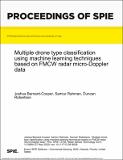Files in this item
Multiple drone type classification using machine learning techniques based on FMCW radar micro-Doppler data
Item metadata
| dc.contributor.author | Bernard-Cooper, Joshua | |
| dc.contributor.author | Rahman, Samiur | |
| dc.contributor.author | Robertson, Duncan A. | |
| dc.contributor.editor | Ranney, Kenneth I. | |
| dc.contributor.editor | Raynal, Ann M. | |
| dc.date.accessioned | 2022-10-24T11:30:01Z | |
| dc.date.available | 2022-10-24T11:30:01Z | |
| dc.date.issued | 2022-05-27 | |
| dc.identifier | 280645187 | |
| dc.identifier | c7fd1ee4-0553-4f72-a4d1-1dbe64158dd5 | |
| dc.identifier | 85135846629 | |
| dc.identifier | 000850453300009 | |
| dc.identifier.citation | Bernard-Cooper , J , Rahman , S & Robertson , D A 2022 , Multiple drone type classification using machine learning techniques based on FMCW radar micro-Doppler data . in K I Ranney & A M Raynal (eds) , Proceedings of SPIE : Radar Sensor Technology XXVI . vol. 12108 , 121080A , Proceedings of SPIE , vol. 12108 , SPIE , SPIE Defense + Commercial Sensing , Orlando , Florida , United States , 3/04/22 . https://doi.org/10.1117/12.2618026 | en |
| dc.identifier.citation | conference | en |
| dc.identifier.isbn | 9781510650923 | |
| dc.identifier.isbn | 9781510650930 | |
| dc.identifier.issn | 0277-786X | |
| dc.identifier.other | ORCID: /0000-0002-4042-2772/work/116597519 | |
| dc.identifier.other | ORCID: /0000-0002-5477-4218/work/116598020 | |
| dc.identifier.uri | https://hdl.handle.net/10023/26232 | |
| dc.description.abstract | Systems designed to detect the threat posed by drones should be able to both locate a drone and ideally determine its type in order to better estimate the level of threat. Previously, drone types have been discriminated using millimeter-wave Continuous Wave (CW) radar, which produces high quality micro-Doppler signatures of the drone propeller blades with fully sampled Doppler spectra. However, this method is unable to locate the target as it cannot measure range. By contrast, Frequency Modulated Continuous Wave (FMCW) data typically undersamples the micro-Doppler signatures of the blades but can be used to locate the target. In this paper we investigate FMCW features of four drones and if they can be used to discriminate the models using machine learning techniques, enabling both the location and classification of the drone. Millimeter-wave radar data are used for better Doppler sensitivity and shorter integration time. Experimentally collected data from Ttree quadcopters (DJI Phantom Standard 3, DJI Inspire 1, and Joyance JT5L-404) and a hexacopter (DJI S900) have been. For classification, feature extraction based machine learning was used. Several algorithms were developed for automated extraction of micro-Doppler strength, bulk Doppler to micro-Doppler ratio, and HERM line spacing from spectrograms. These feature values were fed to classifiers for training. The four models were classified with 85.1% accuracy. Higher accuracies greater than 95% were achieved for training using fewer drone models. The results are promising, establishing the potential for using FMCW radar to discriminate drone types. | |
| dc.format.extent | 14 | |
| dc.format.extent | 998827 | |
| dc.language.iso | eng | |
| dc.publisher | SPIE | |
| dc.relation.ispartof | Proceedings of SPIE | en |
| dc.relation.ispartofseries | Proceedings of SPIE | en |
| dc.subject | Radar | en |
| dc.subject | Drone | en |
| dc.subject | Machine learning | en |
| dc.subject | Doppler effect | en |
| dc.subject | Feature extraction | en |
| dc.subject | Classification systems | en |
| dc.subject | Principal component analysis | en |
| dc.subject | Millimeter wave sensors | en |
| dc.subject | Unmanned aerial vehicles | en |
| dc.subject | QA75 Electronic computers. Computer science | en |
| dc.subject | QC Physics | en |
| dc.subject | NS | en |
| dc.subject.lcc | QA75 | en |
| dc.subject.lcc | QC | en |
| dc.title | Multiple drone type classification using machine learning techniques based on FMCW radar micro-Doppler data | en |
| dc.type | Conference item | en |
| dc.contributor.institution | University of St Andrews. School of Physics and Astronomy | en |
| dc.identifier.doi | 10.1117/12.2618026 |
This item appears in the following Collection(s)
Items in the St Andrews Research Repository are protected by copyright, with all rights reserved, unless otherwise indicated.

